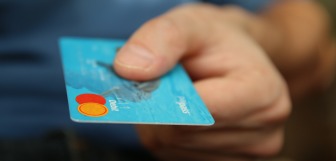How to Accept Credit Card Payments
Here's a fun fact for business owners to know. More and more Americans are joining the cashless society. In fact, according to a Pew Research Center survey, in 2022, roughly four-in-ten Americans (41%) said that none of their purchases in a typical week are paid in cash payments. This percentage is up from 29% in 2018 and 24% in 2015, according to a new Pew Research Center survey.
Because of this, it's absolutely essential that your business offers your customers different ways to pay depending on the methods your customers prefer. One of these methods in credit card payments.
But how does one accept credit card payments? Let’s examine how credit card processing works and how businesses can accept these payments.
Importance of credit card processing for businesses
Credit cards are a super convenient alternative to your customer's carrying cash. But not all merchants accept them. However, with around 82% of U.S. adults owning a credit card, you probably should. Check out some of the benefits below:
Benefits of accepting credit cards
- Your customers may prefer paying with their credit card - Credit card payments were the most popular payment method, according to emarketer. So you definitely should consider accepting credit card payments at your business.
- Your customers will trust shopping with you - When customers see the credit card logos of the top and most popular credit cards you accept, they'll know that your business is trustworthy and legitimate.
- Your customers can have convenience when paying - More and more customers are looking forward to getting rewards (like air miles or cashback) associated with paying with their credit cards. So, while shopping with you, your customers could benefit in other ways. It's a win-win.
How to take credit card payments
Now it's time to get practical. In this section we're going to share some simple steps that you can use to take credit card payments in your retail or hospitality business.
Learn the difference between merchant account and merchant service provider
First things first you need to know the difference between a merchant account (where your funds are temporarily held) and a merchant service provider (who processes your transactions).
Decide how to take payments based on your business type
Next up, you're going to want to tailor your payment strategy to the type of business that you have. Are you a brick-and-mortar retail store? Maybe you're a cool, new, online retailer? Deciding this helps streamline your payment processes and helps to guarantee that you're equipped to accept payments efficiently in various scenarios.
Choose what software you need to collect payments from customers
Now you need to make some choices. Which is the best software to collect payments from your customers? Maybe this is an intuitive app for in-store transactions? Or, a robust payment gateway for online sales? Or you can have the whole point of sale package with a comprehensive retail point-of sale (POS) or innovative hospitality POS covering both. Your choice of software plays an extremely important role in how happy and satisfied your customers are, so be sure to do your research!
Pick the right POS hardware for the ideal payment terminal
Finally, equip yourself with the most modern, cool and, up-to-date POS hardware for an optimal payment experience. This includes selecting reliable card machines, POS terminals, and any other hardware components necessary to facilitate smooth and secure transactions.
f
How to accept credit card payments
Business owners will need a few key items to accept credit and debit cards.
For in-store purchases, you need:
- A partnership with payment processing company
- A card terminal
- A point of sale system (that allows contactless and Pay by Link)
For online purchases, you need:
- An e-commerce website
- A payment gateway
Here's more on how to accept online credit card payments and in store credit card payments.
Take in-store credit card payments
First, you will need to set up a point of sale system. This device will track all your sales, manage your inventory, and execute several other core business functions.
As you ring up a customer, you scan the barcode or enter the product price into your POS system. If they pay with a credit card, your POS will communicate the total price due to your credit card terminal. The customer inserts their credit card, and the process listed above commences. Once payment is verified, the POS confirms the transaction and prints the receipt.
You can obtain a credit card terminal from a payment processing company. These companies not only supply the hardware to accept credit cards, but they will also facilitate the entire transaction for you.
In return for taking care of this process, the companies charge a small fee, which typically falls between 1-3 % of the total transaction price. These transaction fees can be a flat rate or variable, depending on your credit card processor.
TIP: Selling at a farmers market or planning a mobile setup? Don’t miss our guide on the Best POS Systems for Farmers Markets to find the perfect fit for your on-the-go business!
How to accept credit card payments online
Accepting online payments is a great way to open up another revenue stream. If you have an e-commerce website, you have a few ways to accept credit cards. In most cases, you will use an e-commerce platform like Shopify or BigCommerce to build your website. Through these services, you can choose from various payment gateways to accept credit cards. These services are already partnered with the platform, so registering for an account and taking payments only takes a few clicks.
If you build the website through a traditional web builder like WordPress, you will need to find the payment gateway on your own. There are a few ways to set up these gateways, but using plugins is the easiest option.
For example, you can use integrations like the WooCommerce app to build an online store and use its built-in payments section to accept credit and debit cards.
Accept mobile credit card payments
If you want to complement your in-store credit card payments, you should absolutely consider accepting mobile credit card payments as they can make your business flexible and more and more customer's are favoring this method.
Mobile credit card payments allow you to accept physical cards anywhere with no other equipment than your mobile phone. This is done via mobile payment processing apps. These solutions are really lightweight and also a great for sales at on-the-go places, such as trade shows, pop-ups, art fairs and farmers markets.
Epos Now is one of the simplest mobile payment processors out there. Its mobile credit card terminal, the Air, allows business owners to take payments from their pockets with a lightweight, portable, and practical payment solution. The card reader accepts all major debit cards and credit card payments including Visa, MasterCard, American Express, Discover, JCB, and UnionPay. Payments can be made via eWallets for the same rate, including Apple Pay, Google Pay, and Samsung Pay.
Invoices
Handling invoices when you're accepting credit card payments is really important for your business.
To do this, use your POS system to create detailed invoices for each transaction. Here's how:
- Include item descriptions, quantities, prices, taxes, and any discounts.
- Be sure to clearly state payment terms like the due date and accepted payment methods, such as credit cards.
- Send out invoices promptly via email or text to ensure timely payment.
- Keep track of payments using your POS system or accounting software, and follow up with customers as needed.
- Consider integrating your POS system with accounting software for streamlined management.
- Ensure compliance with legal and regulatory requirements for credit card transactions and data protection.
Tip: When managing credit card authorization forms, ensure all required fields are clearly outlined, including cardholder information, authorization amount, and consent signatures. Accuracy and security are paramount to safeguarding sensitive data.
How debit card transactions are different from credit card payments?
Now, debit card and credit card transactions may look similar, however, they're definitely different on the back end. While they’re both facilitated by credit card networks, the POS process looks the same on the customer's end, on the business owner's end, payments look different.
Debit card transactions are often settled quicker, and the payment will land in your merchant account on the same day that it was made. In contrast, credit card processing requires the payment processor to deposit money into your account (and then settle up with the customer later), which can take up to a few days.
Fees are also different depending on the type of account you have with your payment provider. We'll get on to that more in the next section.
Payment processing services made simple
Take integrated payments at one fixed rate, with no hidden fees - anywhere, any time.
Credit card processing fees
Here are the credit card processing fees you'll have to pay:
Interchange rate
This fee is the percentage of the sale that goes directly to Visa, Mastercard, Amex or another credit card company. The rates vary, but they can be anywhere from 1.5% to 3.5% for your traditional card payment companies and even higher for premium credit cards.
Transaction fee
Now onto transaction fees. It's the cut that the business owner pays the payment service provider or payments processor as well as the interchange rate. Some payment processors charge one flat rate per transaction. This tends to cover their cut and the interchange rate. However, others use an interchange-plus model. This charges you the interchange rate plus their own fee.
Service fee
Depending on the provider you choose, you may also have to pay a monthly or annual service fee. Many small business PSPs don't add this fee and charge only flat-rate transaction fees.
TIP: Check out our handy guide to learn which credit card processing is cheapest for small business?
PCI compliance for businesses to be aware when billing credit cards
To safely handle credit card transactions (and try to avoid any chargebacks caused by payment fraud), businesses must follow PCI compliance standards to protect customer data. Luckily, Epos Now meets these standards, saving you from extra validation steps or fees.
While credit card processing costs concern small business owners, offering more payment options can increase sales, offsetting fees. Be sure to look into and analyze how these fees could impact your profits and find ways to balance them.
Now that you know your options, using Epos Now's transparent flat fees can make your business look professional and give customers the payment choices they want, without surprises or extra costs.
Frequently asked questions
- What are the disadvantages of accepting credit card payments?
-
Accepting credit card payments offers tons of benefits that we've listed above, but it also comes with some drawbacks that you should be aware of:
- Transaction fees: Credit card companies charge transaction fees for each transaction, which can add up and eat into your profits, especially for small businesses with lower margins.
- Chargebacks: Customers can dispute charges and request chargebacks, leading to potential losses for your business.
- Security concerns: Credit card transactions involve sensitive customer data, making your business a target for cyberattacks and fraud.
- Delayed funds: It may take several days for funds from credit card transactions to reach your account, impacting your cash flow and liquidity.
- How can I get set up to start taking credit card payments?
-
To start taking payments via credit card, you’re first going to need to pick a payment processor like Epos Now payments. Next, set up a merchant account with them. . For physical stores, you’ll need a POS system or a credit card terminal. For online stores, integrate a payment gateway with your website. Make sure that you comply with security standards (PCI DSS) to protect your customer’s data. Finally, test everything out to make sure it works, train your brilliant team, and then you’re ready to go. It’s that simple!




